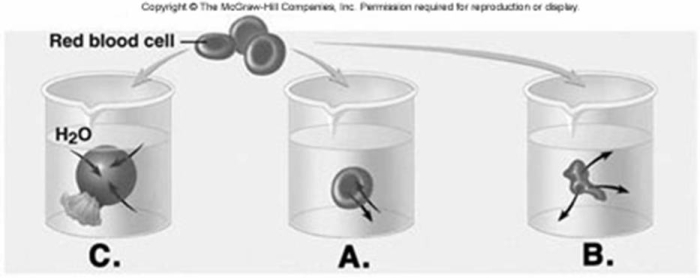A) endoplasmic reticulum
B) Golgi apparatus
C) nucleolus
D) peroxisomes
E) flagellum
G) A) and E)
Correct Answer

verified
Correct Answer
verified
Multiple Choice
If a 0.9% NaCl (saline) solution is isotonic to a cell, then a solution of 3.5% NaCl would be
A) hypertonic to the cell.
B) isotonic to the cell.
C) hypotonic to the cell.
D) catatonic to the cell.
E) All of these choices are correct.
G) A) and B)
Correct Answer

verified
Correct Answer
verified
Multiple Choice
A cell that breaks down and recycles proteins would have large numbers of
A) rough ER.
B) lysosomes.
C) peroxisomes.
D) secretory vesicles.
E) proteosomes.
G) A) and B)
Correct Answer

verified
Correct Answer
verified
Multiple Choice
Which of the following is NOT a G-protein complex protein?
A) delta
B) gamma
C) alpha
D) beta
E) None of these choices are correct.
G) A) and E)
Correct Answer

verified
Correct Answer
verified
Multiple Choice
Which of the following organelles may or may not have ribosomes attached?
A) endoplasmic reticulum
B) Golgi apparatus
C) nucleolus
D) peroxisomes
E) flagellum
G) A) and B)
Correct Answer

verified
Correct Answer
verified
Multiple Choice
The second most abundant of the lipids in the plasma membrane is/are
A) glycolipids.
B) saturated fats.
C) cholesterol.
D) phospholipids.
E) triglycerides.
G) B) and D)
Correct Answer

verified
Correct Answer
verified
Multiple Choice
Cells that respond to ligands
A) possess receptor sites for specific ligands.
B) generally produce the ligands.
C) have lysosomes that destroy the ligands.
D) are using electrical signals in cellular communication.
E) are not functional.
G) B) and D)
Correct Answer

verified
Correct Answer
verified
Multiple Choice
The sequence of nucleotides in a messenger RNA molecule is needed to determine the sequence of
A) nucleotides in a gene.
B) amino acids in a protein.
C) nucleotides in the anticodons of tRNA.
D) codons in DNA.
E) amino acids in DNA.
G) A) and E)
Correct Answer

verified
Correct Answer
verified
Multiple Choice
 -Red blood cells (RBCs) have been placed in three different solutions: hypotonic, hypertonic, isotonic. What is the condition of the RBC in solution "C"?
-Red blood cells (RBCs) have been placed in three different solutions: hypotonic, hypertonic, isotonic. What is the condition of the RBC in solution "C"?
A) hypotonic solution
B) hypertonic solution
C) isotonic solution
D) lyzed
E) crenated
G) A) and B)
Correct Answer

verified
Correct Answer
verified
Multiple Choice
All of the chemical reactions within a cell are known as cell
A) reproduction.
B) metabolism.
C) communication.
D) inheritance.
E) movement.
G) A) and D)
Correct Answer

verified
Correct Answer
verified
Multiple Choice
Nucleoli
A) are located in the cytoplasm.
B) produce ribosomal subunits.
C) have a distinct membrane.
D) are important for the formation of the Golgi apparatus.
E) regulate movement of materials into the nucleus.
G) A) and C)
Correct Answer

verified
Correct Answer
verified
Multiple Choice
If a toxic drug inhibited mRNA synthesis, which of the following would be most directly affected?
A) protein synthesis
B) intracellular digestion
C) microtubule production
D) secretion of glycoproteins and lipoproteins
E) active transport
G) C) and D)
Correct Answer

verified
Correct Answer
verified
Multiple Choice
DNA replication results in two new DNA molecules. Each of these new molecules
A) has two newly synthesized strands of nucleotides.
B) has one strand of nucleotides from the parent DNA and one newly synthesized strand of nucleotides.
C) has two strands of nucleotides from the parent.
D) has a single strand of nucleotides.
E) are incomplete copies of the original.
G) None of the above
Correct Answer

verified
Correct Answer
verified
Multiple Choice
Which of the following would increase the rate of mediated transport?
A) increase the number of available carrier molecules
B) change the shape of the binding site on the carrier molecule
C) increase the number of competitive molecules
D) fill all binding sites on carrier molecules
E) remove the binding site on the carrier molecule
G) A) and C)
Correct Answer

verified
Correct Answer
verified
Multiple Choice
Which of the following is an organelle of locomotion?
A) endoplasmic reticulum
B) Golgi apparatus
C) nucleolus
D) peroxisomes
E) flagellum
G) B) and D)
Correct Answer

verified
Correct Answer
verified
Multiple Choice
A DNA nucleotide sequence that signals the beginning of a gene is called a
A) transcription factor.
B) promoter.
C) triplet.
D) terminator.
E) RNA polymerase.
G) D) and E)
Correct Answer

verified
Correct Answer
verified
Multiple Choice
Which mature cells do not have a nucleus?
A) columnar cells of upper respiratory tract
B) spermatozoa
C) columnar cells of small intestines
D) red blood cells
E) macrophage (large, mobile white blood cell)
G) A) and B)
Correct Answer

verified
Correct Answer
verified
Multiple Choice
Which of the following is CORRECTLY matched with its function?
A) channel proteins - catalyze chemical reactions inside the cell
B) cell identity molecules - are primarily steroids
C) receptor proteins - move specific ions or molecules using ATP
D) peripheral proteins - penetrate the lipid bilayer from one surface to the other
E) carrier proteins - move bound ions or molecules from one side of the membrane to the other
G) A) and E)
Correct Answer

verified
Correct Answer
verified
Multiple Choice
Mitochondria
A) contains DNA.
B) have inner and outer membranes.
C) have inner folds called cristae.
D) are the cell's power plants.
E) All of these choices are correct.
G) D) and E)
Correct Answer

verified
Correct Answer
verified
Multiple Choice
A group of cells was treated with a proteolytic (protein-digesting) enzyme. Which of the following processes would be least affected by this treatment?
A) diffusion of sodium through sodium membrane channels
B) diffusion of lipid-soluble molecules through the plasma membrane
C) use of carrier molecules in facilitated diffusion
D) sodium-potassium exchange pump
E) secondary active transport
G) B) and E)
Correct Answer

verified
Correct Answer
verified
Showing 81 - 100 of 211
Related Exams